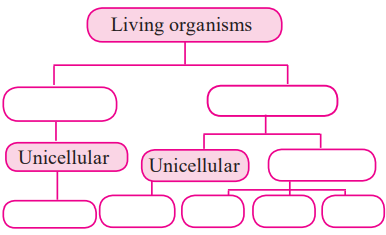Question Answers For All Chapters – General Science Class 8
Exercise
1. Use Whittaker’s method to classify bacteria, protozoa, fungi, algae, prokaryotic and eukaryotic microbes.
→ Kingdom Monera – Bacteria (Prokaryotic, unicellular)
→ Kingdom Protista – Protozoa, Algae (Eukaryotic, unicellular)
→ Kingdom Fungi – Fungi (Eukaryotic, multicellular, saprophytic)
2. Complete the five-kingdom method of classification.
3. Find out my partner.
| Group A | Group B |
|---|---|
| Fungi | Candida |
| Protozoa | Amoeba |
| Virus | Bacteriophage |
| Algae | Chlorella |
| Bacteria | Prokaryotic |
4. State whether the following statements are true or false. Explain your statement.
(a) Lactobacilli are harmful bacteria.
→ False, lactobacilli help in curd formation and digestion.
(b) The cell wall of fungi is made up of chitin.
→ True, fungi have a chitin cell wall instead of cellulose.
(c) The organ of locomotion in amoeba is pseudopodia.
→ True, amoeba moves using pseudopodia (false feet).
(d) Tomato wilt is a viral disease.
→ True, it is caused by the Tomato Wilt Virus.
5. Give answers.
(a) State the merits of Whittaker’s method of classification.
→ It groups organisms based on cell structure, nutrition, and lifestyle and separates prokaryotes and eukaryotes.
(b) Write the characteristics of viruses.
→ Viruses are non-living outside host cells, very tiny (10-100 nm), and contain DNA or RNA covered by a protein coat.
(c) Explain the nutrition in fungi.
→ Fungi are saprotrophic, meaning they absorb nutrients from decaying organic matter.
(d) Which living organisms are included in the kingdom Monera?
→ Monera includes bacteria and blue-green algae (cyanobacteria), which are unicellular and prokaryotic.
6. Who am I?
(a) I don’t have a true nucleus, cell organelles, or plasma membrane. → Virus
(b) I have a nucleus and membrane-bound cell organelles. → Eukaryote
(c) I live on decaying organic matter. → Fungus
(d) I reproduce mainly by cell division. → Bacteria
(e) I can produce my replica. → Virus
(f) I am green but don’t have organs. → Algae
7. Draw neat and labeled diagrams.
- Different types of bacteria (Coccus, Bacillus, Spirillum, Vibrio)
- Paramoecium (with nucleus, cilia, and food vacuole)
- Bacteriophage (with head, tail fibers, and DNA)
8. Arrange the following in ascending order of size Bacteria, Fungi, Viruses, Algae.
Viruses < Bacteria < Fungi < Algae


Leave a Reply